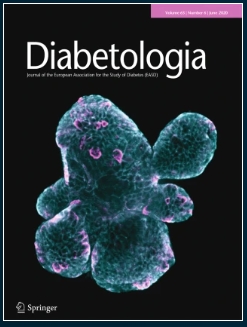1型糖尿病妇女的不良妊娠结局与阴道微生物群的多种改变有关。
IF 10.2
1区 医学
Q1 ENDOCRINOLOGY & METABOLISM
引用次数: 0
摘要
目的/假设阴道微生物群与不良妊娠结局有关,1型糖尿病患者的不良妊娠结局明显增加。为了研究这种关系,我们分析了患有和不患有1型糖尿病的孕妇阴道微生物群,以及与1型糖尿病妇女早产(PTB)和先兆子痫(PE)的关系。方法采用16S rRNA基因和内部转录间隔序列1测序方法,对310例妊娠晚期(160例1型糖尿病)的细菌和147例妊娠晚期(70例1型糖尿病)的真菌微生物组进行分析。结果妊娠期1型糖尿病改变了阴道微生物群,增加了乳杆菌和延sen乳杆菌,增加了加德纳菌、厌氧球菌、普雷沃氏菌、Dialister、Peptoniphilus等与阴道生态失调有关的厌氧菌。此外,1型糖尿病患者真菌种类马拉色菌的丰度增加。这些变化与PTB和PE的风险增加有关。PTB与细菌α多样性增加,罗伊氏乳杆菌丰度降低,马拉色菌属、马拉色菌科和马拉色菌目真菌丰度增加有关。PE与较高的细菌多样性、阴道加德纳菌的丰度增加和白色念珠菌的丰度减少有关。结论/解释阴道微生物组的明显变化反映了1型糖尿病妇女的不良妊娠结局。这突出了监测和管理阴道微生物组在高危妊娠中的重要性,特别是那些伴有1型糖尿病的妊娠。早期发现和治疗与风险相关的类群,例如PE病例中的阴道支原体,可能会改善1型糖尿病妇女的阴道健康和妊娠结局。本文章由计算机程序翻译,如有差异,请以英文原文为准。
Adverse pregnancy outcomes in women with type 1 diabetes are associated with multiple alterations in the vaginal microbiome.
AIMS/HYPOTHESIS
The vaginal microbiome has been linked to adverse pregnancy outcomes, which are markedly increased in women with type 1 diabetes. To investigate this relationship, we profiled the vaginal microbiome in pregnant women with and without type 1 diabetes, and in relation to pre-term birth (PTB) and pre-eclampsia (PE) in women with type 1 diabetes.
METHODS
Bacterial and fungal microbiomes were analysed by 16S rRNA gene and internal transcribed spacer 1 sequencing, respectively, in the third trimester of 310 pregnancies (160 with type 1 diabetes) for bacteria, and 147 pregnancies (70 with type 1 diabetes) for fungi.
RESULTS
The vaginal microbiome was altered by type 1 diabetes in pregnancy, with an increase in the bacterial species Lactobacillus iners and Lactobacillus jensenii, and in the anaerobic genera Gardnerella, Anaerococcus, Prevotella, Dialister, Peptoniphilus and others that are associated with vaginal dysbiosis. In addition, the abundance of the fungal species Malassezia restricta was increased in women with type 1 diabetes. These changes were associated with increased risks of PTB and PE. PTB was associated with higher bacterial alpha diversity, decreased abundance of Lactobacillus reuteri, and increased abundance of Malassezia fungal genus, family Malasseziaceae and order Malasseziales. PE was associated with higher bacterial alpha diversity, increased abundance of Gardnerella vaginalis and decreased abundance of Candida albicans.
CONCLUSIONS/INTERPRETATION
Adverse pregnancy outcomes in women with type 1 diabetes are reflected by distinct changes in the vaginal microbiome. This highlights the importance of monitoring and managing the vaginal microbiome in high-risk pregnancies, particularly those complicated by type 1 diabetes. Early detection and treatment of risk-associated taxa, e.g. G. vaginalis in the case of PE, could potentially improve vaginal health and pregnancy outcomes in women with type 1 diabetes.
求助全文
通过发布文献求助,成功后即可免费获取论文全文。
去求助
来源期刊

Diabetologia
医学-内分泌学与代谢
CiteScore
18.10
自引率
2.40%
发文量
193
审稿时长
1 months
期刊介绍:
Diabetologia, the authoritative journal dedicated to diabetes research, holds high visibility through society membership, libraries, and social media. As the official journal of the European Association for the Study of Diabetes, it is ranked in the top quartile of the 2019 JCR Impact Factors in the Endocrinology & Metabolism category. The journal boasts dedicated and expert editorial teams committed to supporting authors throughout the peer review process.
 求助内容:
求助内容: 应助结果提醒方式:
应助结果提醒方式:


